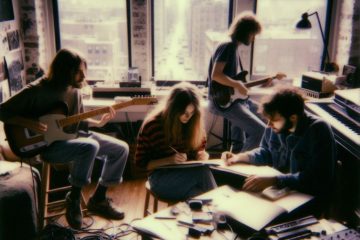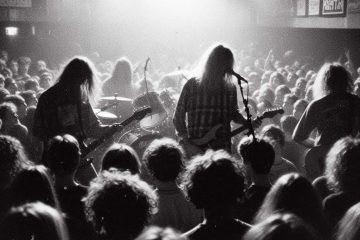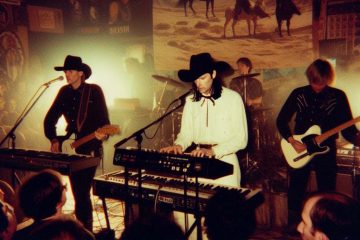I recently finished a fascinating book called The Song Machine: Inside the Hit Song Factory by John Seabrook.
It’s a very readable account of modern pop music from the late 90s until 2015. Better still it contains compelling details from a lot of the main players responsible for some of the biggest hits in the last 20 years. Definitely worth a read even if you’re not a pop music fan.
I could say a lot more about the book and I might even get around to doing a summary of it at some point. For now I thought it might be helpful to pull out some two of the songwriting ideas which I pieced together whilst reading the book.
Tip #1 – It’s What You Leave Out
“It’s much more difficult to make it simple, especially achieving simplicity without having it sound incredibly trivial.” Denniz PoP
Denniz PoP is a character that features a lot in this book. Denniz was responsible for bringing us Ace of Base, Brittney Spears and the Backstreet Boys to name a few. He is also responsible for helping mentor a young glam rock singer, Martin Sandberg. You might have heard of his name Max Martin. More about him later.
Denniz PoP was a DJ who started to remix songs in the 80s. He went on to create original music in the late 80s and through the 90s for some very popular artists.
People described Denniz as an arrangement genius. His was particularly good at removing things to make the sound picture clearer.
For Ace of Base he removed up to 50% of the arrangement on their hit All That She Wants. It wasn’t about minimalism either. For Denniz it went further. As Martin Dodd says in The Music Machine: “nothing was allowed to be “nice” or boring; absolutely every note, word and beat had to have a purpose or be fun.”
Give It A Go
Try stripping back a completed arrangement of one of your own songs to the minimum necessary parts. From a production point of view this helps make the mix less cluttered. It also highlights which parts are actually really good and adding something too the song. It will also highlight what might need work or need to be removed because they are taking away from the song.
It also really helps you to think about the sound of each part and how they fit together. Is your guitar part too busy? Are two melodic parts competing rather than complimenting each other. Rather than shoehorn musical elements which don’t really work together should the sound itself be changed or removed?
In The Mix
From a mix point of view, is that guitar part too thin and needs to be beefier? Rather than trying studio tricks, try re-recording it with the sound you hear in your head. Should the vocal be sung with a softer tone rather than EQing it to make it sit better? Does that synth part need more edge to make it cut through – try changing the sound rather than leaving it until mixing.
Your track should sound pretty solid by just balancing the levels of the parts. If it’s not working is it the actual sounds themselves? Thinking about this as you’re building up an arrangement will help you become more decisive, confident and result in more polished sounding songs.
Bonus Round:
On a macro level, does the track lose the flow/energy at any point? How can you fix that section? Sometimes a dead-zone means you need to control the energy of the track in a certain way. Does it need to go up in energy, does it need to pull back, does it need to flow or should you just get rid of it all together?
Tip #2 – Track-And-Hook Songwriting
This method of songwriting is where a beat maker/producer develops a very polished demo. They collaborate with a “top-liner” who specialises in developing a lead vocal melodies.
It is different from the more traditional melody and lyrics first approach. Where the arrangement comes later in support of these elements.
A Modern Songwriting Trend?
This type of songwriting approach gained popularity in the 2000s. As the book recounts, this method developed in Jamaica. Reggae producers would create a “riddum”(rhythm) track. Then they would invite aspiring singers to bring a melody and lyrics to fit it. Sort of a back to front version of the traditional melody and lyrics first approach.
In a way it’s like jamming along to a track and seeing what comes out. It also places emphasis on the rhythm section. This makes these types of songs far more groove/beat focussed.
Its a form of songwriting allows producers to batch their songwriting writing process. Then they outsource the top-line to quite many different singers with that skill set.
Keep Melody Writing Simple
This type of songwriting also encourages a “first thought, best thought” approach. It reminds me of those stories you hear recounted by writers of the song coming together in an hour or less. They are running with the most natural melodies and hooks without getting caught up in the process.
I’ve tried this method myself a bit and have found it very rewarding and creative. The songs I’ve written out of employing this style of writing have a spontaneity and freshness about them.
Give It A Go
Try finding a beat (YouTube: pop beat instrumentals or rock beat instrumental) and try “jamming” along with the track. See what falls out. It’s a fun and freeing way to spend 15 – 30 minutes and you might come up with something you like.
Even if you’re not a singer just try and get in that space of freestyling and finding hooks. It’s good to expose yourself to this type of process. The more you do it, the easier it becomes and it’s a good skill to have in your songwriting bag of tricks.
In The Mix
If you’re a songwriter who has production skills and you’ve never tried this approach. Try creating a verse, chorus structure in your DAW with some loops. It doesn’t have to be polished, just something that starts to get you inspired.
Once you’ve got that basic structure start recording on your voice recorder on your phone. Now try jamming along vocally – you don’t need to be a good singer. Cycle the sections and try things out until you find something you like. If you can remember it, hit record and get it down otherwise refer to your voice recording.
Most of all have some fun and expand on your songwriting experiences.
Do You Really Want To See The Song Machine?
As much as the song machine is about writing uber pop songs and the business surrounding it I feel this book is helpful for songwriters in general. If you are discerning you can find plenty of songwriting nuggets which can inspire and direct your creative process.
It is also an eye opening look at the top “elite” of the music business, both artist, production and business personalities. It’s another world in many ways and one that artists aspiring to those levels should take a look at to see all that they are potentially signing up for. 😉
I’d definitely suggest trying both of the ideas above out for yourself especially if you’ve never done something like that before.
Happy songwriting and producing.
Want some more song writing tips from famous songwriters:



0 Comments